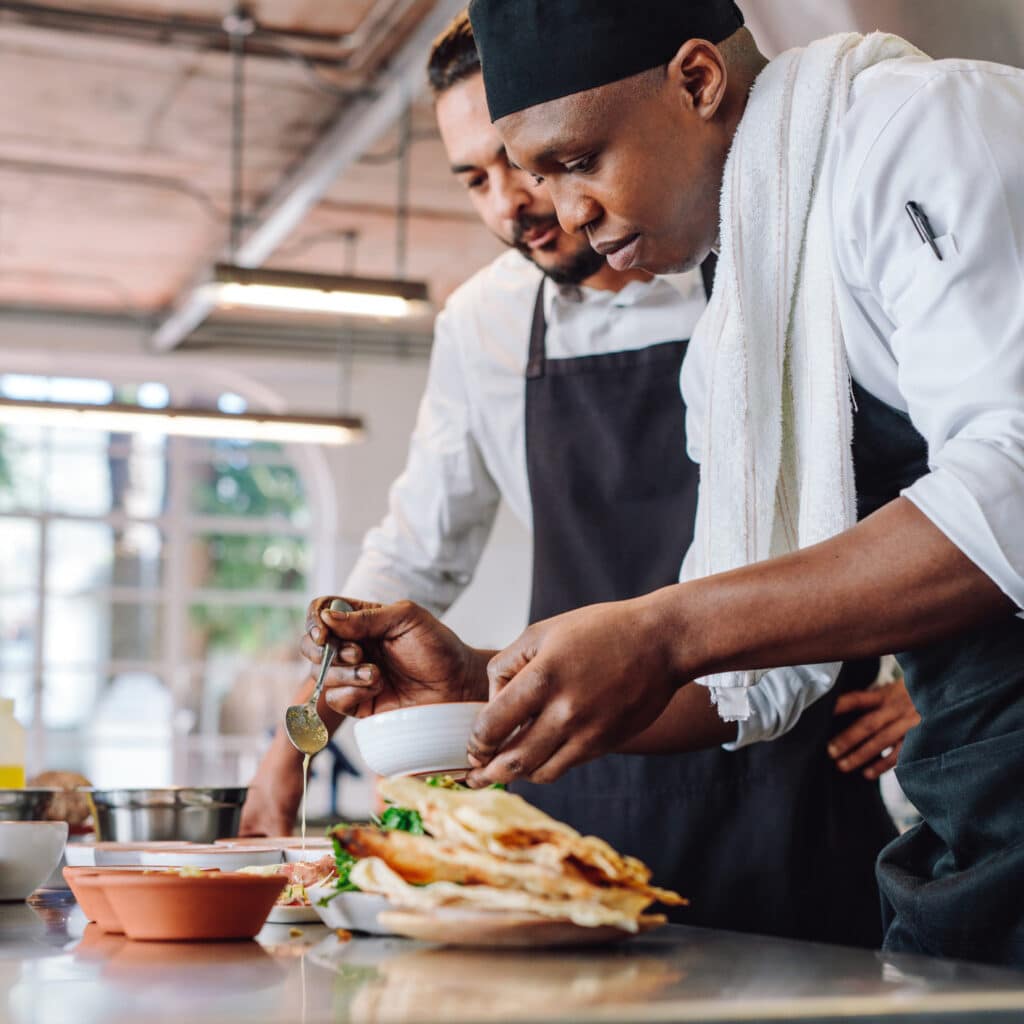Controlling your restaurant’s prime cost, made up of your cost of goods sold (CoGS) and labor costs, is critical to your profitability. Prime cost represents the two largest controllable costs for your restaurant – food and labor. When you are able to lower your prime cost, even by a few percentage points, that is profit added back directly to your bottom line.
There are many different approaches to lower prime cost, from menu engineering to actual vs. scheduled labor tracking. However, ultimately, all techniques hinge on the same thing: real-world application on the store level. At the foundation, it is your managers who lead the day-to-day work optimizing food and labor costs.
Controlling your restaurant prime cost
depends on empowering your store-level managers to access data in the systems you implement. So, how do you empower your store-level managers?
Rethinking manager accountability and empowerment
Whether you have a few locations or dozens, the success of the business depends on the performance of the individual locations. Your managers are your first line of success empowerment, and it’s worth examining the idea of manager accountability and empowerment.
Provide Managers with a Roadmap for Success
First, it’s not enough to just set numbers that managers are responsible for hitting. Instead, set managers up for success by providing a map to help guide them to prime cost goals, with detailed data in hand.
For example, managers at all of your locations should have a clear idea of their budgets for restaurant prime cost. This budget should lay out the larger goals, but it should also provide CoGS and labor data broken down by week, day, or even day part. The more information managers have on their road map, the more often they can check in to make sure they’re on track.
Recognize Manager Success and Share the Credit
If you are going to hold your managers responsible for prime cost numbers, it’s also important to examine how your company approaches accountability. Many people associate accountability as taking the blame if something goes wrong. However, accountability also means sharing the credit for success — or empowering them to be successful.
As you work to empower your managers, think about the process as more like a coach and make sure all your managers understand your approach. When manager success is recognized and appreciated, you are sending the signal to managers at all your locations that they are partners in the company’s success. With a healthy culture around empowerment, you can grow your team’s drive and motivation.
Train Managers to Control Food and Labor Costs
Finally, after arming your managers with the plans they need and setting clear expectations for success, invest in manager training for controlling restaurant prime cost.
Empowerment means more metrics to track. To prevent your managers from getting lost in back-office paperwork, part of your restaurant manager training should focus on how to leverage automated restaurant operations reporting, (see details in the next section.) Ultimately, you want to make sure your managers are empowered to control costs, while still having time to be hands-on with their own teams in your restaurants.
Tips for managers to control prime cost
With additional higher costs for off-premise channels, your restaurant prime cost may have increased during the COVID-19 pandemic. It is more important than ever for store-level managers to keep an eye on prime cost on a daily and weekly basis. Here are some tips for managers to get started controlling their food and labor costs.
1. Know Your Optimum Sales and Number of Customers Served Per Labor Hour for Each Day Part
Your point-of-sale (POS) system can connect your labor hours to the sales generated or customers served per labor hour. This sales per labor hour (SPLH) metric is a key measure of the productivity of your staff.
A low SPLH can indicate possible scheduling problems, and an especially high number can result in poor customer service. The goal SPLH number represents optimal productivity and customer experience at your multi-unit locations.
Even if your restaurant is restricted from doing dine-in and you’re limited to takeout, curbside, or delivery, monitoring your SPLH across these different channels ensures you are matching your labor to track sales. As you track SPLH, pay close attention to how it changes by day part to inform future scheduling.
2. Review Cost of Goods Sold and Labor Reports Daily
Your long-term CoGS and labor costs are determined by what happens in your restaurant day-to-day. Frequently reviewing food and labor cost data helps your managers become aware of issues quickly so that they can take immediate action.
By tracking your sales per labor hour (SPLH), mentioned above, your managers can make real-time changes to scheduling that can improve this percentage. Examining your food cost daily informs your ordering and inventory management.
Prime cost should be examined in light of your sales forecasts as part of your restaurant reporting software. A more frequent review allows you to not just track quarterly or weekly trends, but also analyze on a daily or even hourly basis. Over time, the small tweaks your managers make on the store level add up to meet prime cost goals.
3. Evaluate Suppliers and Supply Costs Regularly
Your vendor prices have a large impact on your CoGS. By keeping a regular eye on your supplier ingredient prices, you can proactively keep supply costs low.
Regularly examining vendor prices allows you to spot pricing errors and stay ahead of any pricing trends. If prices have risen with a specific supplier, you or your store-level managers can always try to negotiate for a lower contract price. If needed, you may also have the opportunity to compare other vendor costs and seek out an alternative agreement or brand.
4. Use Purchase Orders and Buy Only What You Need
Minimizing food waste is essential to keeping a low CoGS. Waste, spoilage, and over-portioning are common for multi-unit restaurant groups that purchase too much inventory or rely on inaccurate inventory numbers.
Encourage your managers to use purchase orders when ordering, which give a record of what is ordered, the quantity, and the quoted price. When an order arrives at the restaurant, your managers can verify that what they received matches what is on the vendor’s invoice.
Purchasing product doesn’t need to be completely time consuming. To streamline the ordering process, consider leveraging smart inventory management tools that offer suggestive product ordering.
5. Cost Out Your Menu Items and Recipes
Profitability does rely on meeting sales goals, but it’s easy to forget another important piece: meeting specific cost targets.
Costing out your recipes and menu items means breaking down every single item into individual ingredients, and calculating the cost to the penny. When your managers know the exact cost of menu items, they can examine how profit margin is contributing to their profitability goals.
The right tools can automate this laborious process. With a robust inventory system, a POS integrated with your restaurant operations software, and standard recipes, you can import menu items from your POS and map them to recipes.
6. Focus on Selling Your Highest Gross Profit Menu Items
Once you know the exact cost of your menu items, you can focus on the profit margin you are making on each item given the menu price.
To optimize your overall food costs, focus on selling the menu items with the highest profit margin. Once you have accurate recipe costing data, your managers can monitor profit margin if it fluctuates with ingredient changes as well.
Especially if you are limiting your menu for dine-in or delivery during the COVID-19 pandemic, ensuring the items your restaurants are selling have high profit margins is essential to keeping a healthy food cost.
7. Calculate Your Theoretical Food Cost Regularly
When you’re controlling your food costs, you need to know where the baseline is. Your theoretical food cost is what you should have spent to prepare the menu items that were sold. It represents the expense with perfect portioning, no waste, and no errors.
When your managers know their theoretical food cost, they can compare it to their actual food cost (what your restaurant really spent on
food during the same time period). The difference between the actual vs. theoretical food cost (AvT) represents the variance, or the leak in your profits due to over portioning, waste, or errors. Once your managers can spot where there is AvT variance in your food costs, they know where to start focusing their efforts to minimize waste.
8. Schedule Prep for Off-peak Meal Periods
To make the best use of labor, your managers should consider scheduling prep during non-peak times. This arrangement can ensure they have the necessary staff if they get an unexpected rush, while also efficiently using their labor hours.
If your store sales have fluctuated during the pandemic, this off-peak prep also allows for flexibility in reevaluating par levels for prepped items to avoid food waste as well.
9. Leverage High-value Employees
Finally, making smart choices about how to schedule the most efficient or productive staff can help optimize labor spend. Your managers should track labor costs against labor percentage goals on a daily basis to see how labor is matching sales trends in real time. They can segment these labor costs between front and back of house or day part to get a more data-driven look at their labor costs.
Conclusion
Prime cost is always going to fluctuate, but by empowering your store-level managers to control their restaurants’ prime cost destiny, they can meet the challenge and add to the bottom line of your multi-unit restaurant group. Evaluating metrics daily, and on the store-level, is a first line of attack in controlling restaurant prime cost at all your locations.
If you’d like to give your managers the tools they need to effectively control prime cost, consider an all-in-one restaurant management system, now with the new Smart Ops Release. Restaurant365 incorporates restaurant accounting software, restaurant operations software, inventory management software, payroll + HR software, and scheduling software into a cloud-based platform that’s fully integrated with your POS system, as well as to your food and beverage vendors, and bank. Ask for a free demo of R365 today.



